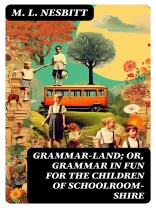In ‘Grammar-land; Or, Grammar in Fun for the Children of Schoolroom-shire’ by M. L. Nesbitt, readers are taken on a whimsical journey through the intricate world of grammar presented in a playful and engaging manner. The book is a unique blend of educational content and storytelling, making grammar concepts accessible to young readers while keeping them entertained. Nesbitt’s literary style is characterized by witty dialogue and creative wordplay, setting a fun tone throughout the book. The use of imaginative characters and settings adds depth and interest to the grammar lessons, making them more memorable and enjoyable for readers. Within the literary context of children’s educational literature, ‘Grammar-land’ stands out as a creative and effective approach to teaching grammar. It successfully combines learning with entertainment, making it a valuable resource for young students. M. L. Nesbitt’s background in education and passion for language likely inspired him to write this innovative book. His expertise in simplifying complex concepts for young learners is evident in the way he presents grammar in a fun and engaging way. I highly recommend ‘Grammar-land; Or, Grammar in Fun for the Children of Schoolroom-shire’ to parents and educators looking for a creative and effective tool to teach grammar to children. It is a delightful and educational read that will captivate young readers while helping them grasp essential language skills.
About the author
M. L. Nesbitt, whose full name and personal history remain enigmatic, is an author best known for the didactic children’s book ‘Grammar-land; Or, Grammar in Fun for the Children of Schoolroom-shire.’ Published in the latter half of the 19th century, this work reflects the Victorian era’s educational values and pedagogical strategies, aiming to teach grammar through an imaginative narrative that is both engaging and instructive for young readers. Embedding English language rules within a fictional realm, Nesbitt’s approach was particularly innovative for its time, aligning with the principles of learning through play. While little is known about Nesbitt’s life or other literary contributions, ‘Grammar-land’ is indicative of a whimsical and effective literary style, characterized by personification and storytelling. Nesbitt’s commitment to education is evidenced by the lasting appeal of ‘Grammar-land, ‘ which continues to be referenced in contemporary discussions of grammar instruction and historical literature aimed at children. Despite the scarcity of biographical details, Nesbitt’s legacy endures via this singular contribution to English grammar literature, suggesting a nuanced understanding of language and an admirable dedication to making learning accessible to the youth of the author’s time.












